Why Have Canadian Legislators, Police, and Courts Responded to Indigenous Resistance With Such Force?
VerifiedAdded on 2022/09/05
|6
|2466
|23
AI Summary
Contribute Materials
Your contribution can guide someone’s learning journey. Share your
documents today.
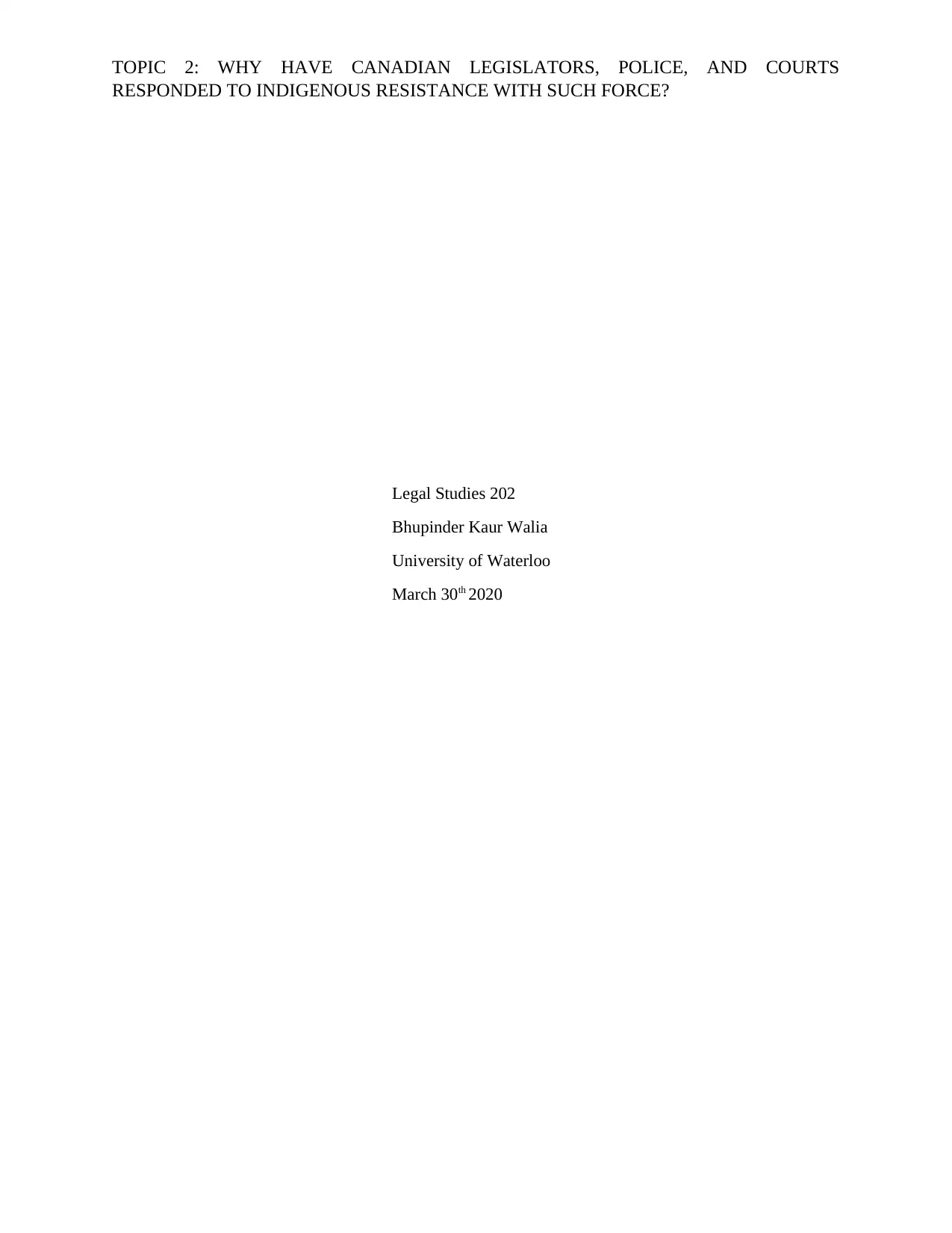
TOPIC 2: WHY HAVE CANADIAN LEGISLATORS, POLICE, AND COURTS
RESPONDED TO INDIGENOUS RESISTANCE WITH SUCH FORCE?
Legal Studies 202
Bhupinder Kaur Walia
University of Waterloo
March 30th 2020
RESPONDED TO INDIGENOUS RESISTANCE WITH SUCH FORCE?
Legal Studies 202
Bhupinder Kaur Walia
University of Waterloo
March 30th 2020
Secure Best Marks with AI Grader
Need help grading? Try our AI Grader for instant feedback on your assignments.
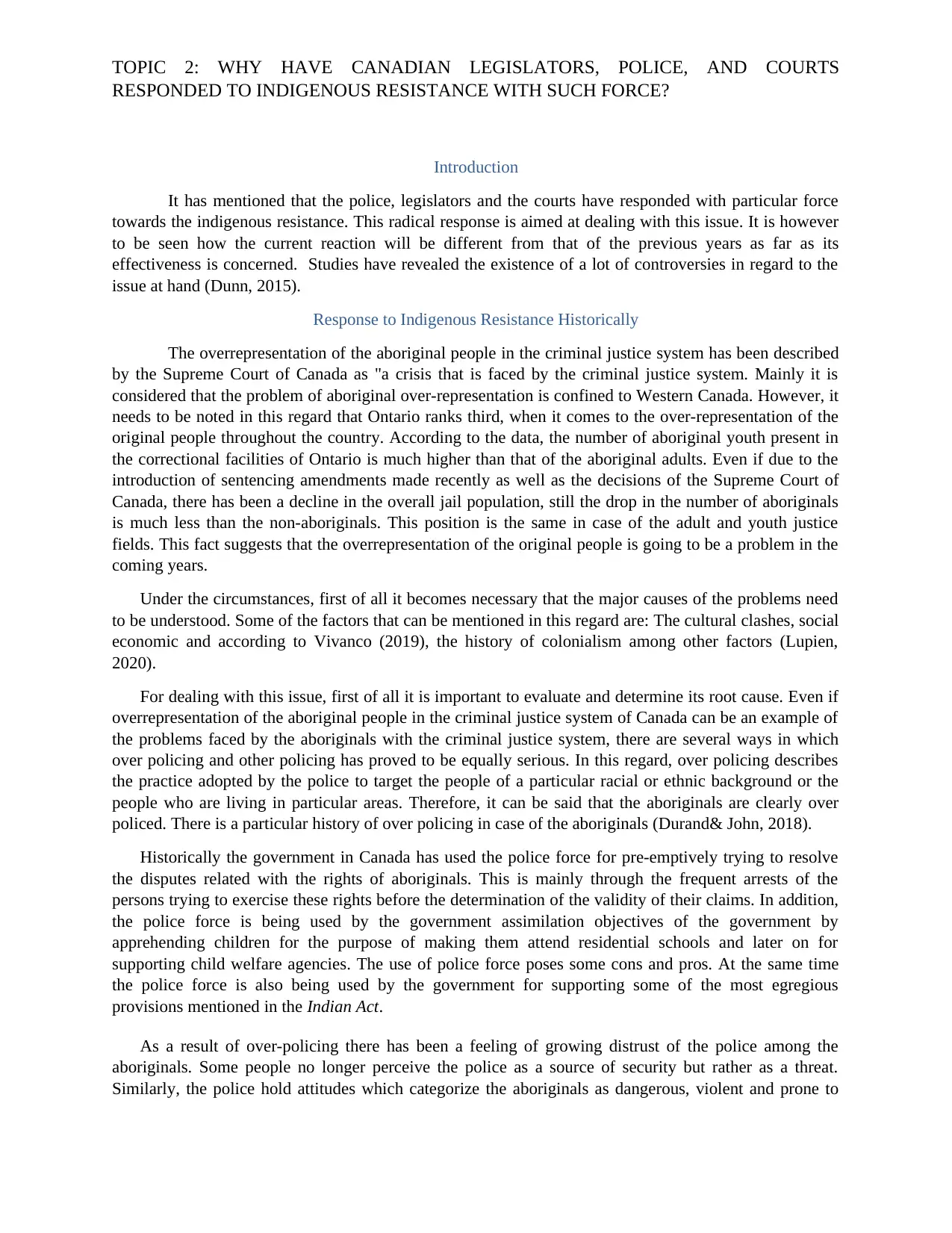
TOPIC 2: WHY HAVE CANADIAN LEGISLATORS, POLICE, AND COURTS
RESPONDED TO INDIGENOUS RESISTANCE WITH SUCH FORCE?
Introduction
It has mentioned that the police, legislators and the courts have responded with particular force
towards the indigenous resistance. This radical response is aimed at dealing with this issue. It is however
to be seen how the current reaction will be different from that of the previous years as far as its
effectiveness is concerned. Studies have revealed the existence of a lot of controversies in regard to the
issue at hand (Dunn, 2015).
Response to Indigenous Resistance Historically
The overrepresentation of the aboriginal people in the criminal justice system has been described
by the Supreme Court of Canada as "a crisis that is faced by the criminal justice system. Mainly it is
considered that the problem of aboriginal over-representation is confined to Western Canada. However, it
needs to be noted in this regard that Ontario ranks third, when it comes to the over-representation of the
original people throughout the country. According to the data, the number of aboriginal youth present in
the correctional facilities of Ontario is much higher than that of the aboriginal adults. Even if due to the
introduction of sentencing amendments made recently as well as the decisions of the Supreme Court of
Canada, there has been a decline in the overall jail population, still the drop in the number of aboriginals
is much less than the non-aboriginals. This position is the same in case of the adult and youth justice
fields. This fact suggests that the overrepresentation of the original people is going to be a problem in the
coming years.
Under the circumstances, first of all it becomes necessary that the major causes of the problems need
to be understood. Some of the factors that can be mentioned in this regard are: The cultural clashes, social
economic and according to Vivanco (2019), the history of colonialism among other factors (Lupien,
2020).
For dealing with this issue, first of all it is important to evaluate and determine its root cause. Even if
overrepresentation of the aboriginal people in the criminal justice system of Canada can be an example of
the problems faced by the aboriginals with the criminal justice system, there are several ways in which
over policing and other policing has proved to be equally serious. In this regard, over policing describes
the practice adopted by the police to target the people of a particular racial or ethnic background or the
people who are living in particular areas. Therefore, it can be said that the aboriginals are clearly over
policed. There is a particular history of over policing in case of the aboriginals (Durand& John, 2018).
Historically the government in Canada has used the police force for pre-emptively trying to resolve
the disputes related with the rights of aboriginals. This is mainly through the frequent arrests of the
persons trying to exercise these rights before the determination of the validity of their claims. In addition,
the police force is being used by the government assimilation objectives of the government by
apprehending children for the purpose of making them attend residential schools and later on for
supporting child welfare agencies. The use of police force poses some cons and pros. At the same time
the police force is also being used by the government for supporting some of the most egregious
provisions mentioned in the Indian Act.
As a result of over-policing there has been a feeling of growing distrust of the police among the
aboriginals. Some people no longer perceive the police as a source of security but rather as a threat.
Similarly, the police hold attitudes which categorize the aboriginals as dangerous, violent and prone to
RESPONDED TO INDIGENOUS RESISTANCE WITH SUCH FORCE?
Introduction
It has mentioned that the police, legislators and the courts have responded with particular force
towards the indigenous resistance. This radical response is aimed at dealing with this issue. It is however
to be seen how the current reaction will be different from that of the previous years as far as its
effectiveness is concerned. Studies have revealed the existence of a lot of controversies in regard to the
issue at hand (Dunn, 2015).
Response to Indigenous Resistance Historically
The overrepresentation of the aboriginal people in the criminal justice system has been described
by the Supreme Court of Canada as "a crisis that is faced by the criminal justice system. Mainly it is
considered that the problem of aboriginal over-representation is confined to Western Canada. However, it
needs to be noted in this regard that Ontario ranks third, when it comes to the over-representation of the
original people throughout the country. According to the data, the number of aboriginal youth present in
the correctional facilities of Ontario is much higher than that of the aboriginal adults. Even if due to the
introduction of sentencing amendments made recently as well as the decisions of the Supreme Court of
Canada, there has been a decline in the overall jail population, still the drop in the number of aboriginals
is much less than the non-aboriginals. This position is the same in case of the adult and youth justice
fields. This fact suggests that the overrepresentation of the original people is going to be a problem in the
coming years.
Under the circumstances, first of all it becomes necessary that the major causes of the problems need
to be understood. Some of the factors that can be mentioned in this regard are: The cultural clashes, social
economic and according to Vivanco (2019), the history of colonialism among other factors (Lupien,
2020).
For dealing with this issue, first of all it is important to evaluate and determine its root cause. Even if
overrepresentation of the aboriginal people in the criminal justice system of Canada can be an example of
the problems faced by the aboriginals with the criminal justice system, there are several ways in which
over policing and other policing has proved to be equally serious. In this regard, over policing describes
the practice adopted by the police to target the people of a particular racial or ethnic background or the
people who are living in particular areas. Therefore, it can be said that the aboriginals are clearly over
policed. There is a particular history of over policing in case of the aboriginals (Durand& John, 2018).
Historically the government in Canada has used the police force for pre-emptively trying to resolve
the disputes related with the rights of aboriginals. This is mainly through the frequent arrests of the
persons trying to exercise these rights before the determination of the validity of their claims. In addition,
the police force is being used by the government assimilation objectives of the government by
apprehending children for the purpose of making them attend residential schools and later on for
supporting child welfare agencies. The use of police force poses some cons and pros. At the same time
the police force is also being used by the government for supporting some of the most egregious
provisions mentioned in the Indian Act.
As a result of over-policing there has been a feeling of growing distrust of the police among the
aboriginals. Some people no longer perceive the police as a source of security but rather as a threat.
Similarly, the police hold attitudes which categorize the aboriginals as dangerous, violent and prone to
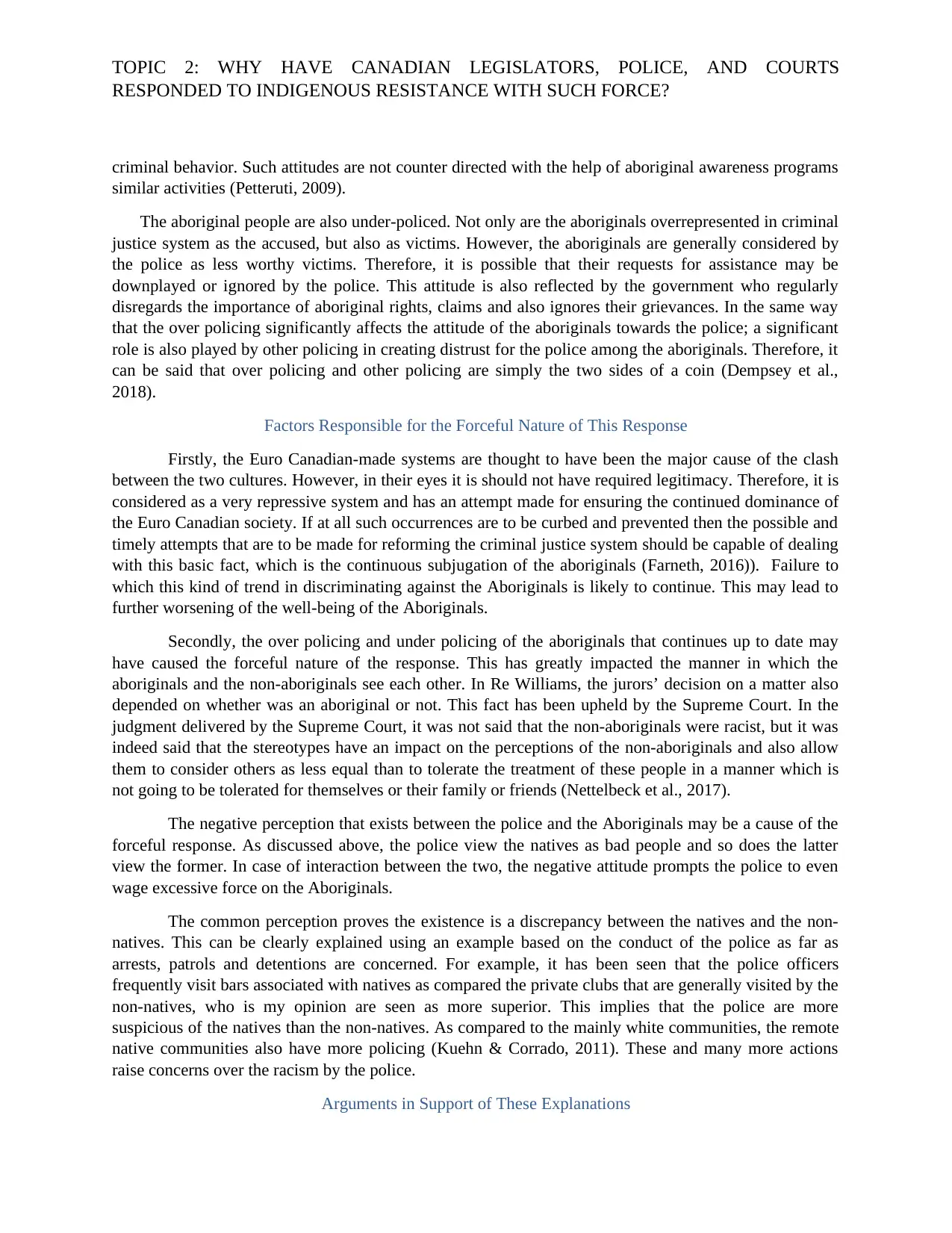
TOPIC 2: WHY HAVE CANADIAN LEGISLATORS, POLICE, AND COURTS
RESPONDED TO INDIGENOUS RESISTANCE WITH SUCH FORCE?
criminal behavior. Such attitudes are not counter directed with the help of aboriginal awareness programs
similar activities (Petteruti, 2009).
The aboriginal people are also under-policed. Not only are the aboriginals overrepresented in criminal
justice system as the accused, but also as victims. However, the aboriginals are generally considered by
the police as less worthy victims. Therefore, it is possible that their requests for assistance may be
downplayed or ignored by the police. This attitude is also reflected by the government who regularly
disregards the importance of aboriginal rights, claims and also ignores their grievances. In the same way
that the over policing significantly affects the attitude of the aboriginals towards the police; a significant
role is also played by other policing in creating distrust for the police among the aboriginals. Therefore, it
can be said that over policing and other policing are simply the two sides of a coin (Dempsey et al.,
2018).
Factors Responsible for the Forceful Nature of This Response
Firstly, the Euro Canadian-made systems are thought to have been the major cause of the clash
between the two cultures. However, in their eyes it is should not have required legitimacy. Therefore, it is
considered as a very repressive system and has an attempt made for ensuring the continued dominance of
the Euro Canadian society. If at all such occurrences are to be curbed and prevented then the possible and
timely attempts that are to be made for reforming the criminal justice system should be capable of dealing
with this basic fact, which is the continuous subjugation of the aboriginals (Farneth, 2016)). Failure to
which this kind of trend in discriminating against the Aboriginals is likely to continue. This may lead to
further worsening of the well-being of the Aboriginals.
Secondly, the over policing and under policing of the aboriginals that continues up to date may
have caused the forceful nature of the response. This has greatly impacted the manner in which the
aboriginals and the non-aboriginals see each other. In Re Williams, the jurors’ decision on a matter also
depended on whether was an aboriginal or not. This fact has been upheld by the Supreme Court. In the
judgment delivered by the Supreme Court, it was not said that the non-aboriginals were racist, but it was
indeed said that the stereotypes have an impact on the perceptions of the non-aboriginals and also allow
them to consider others as less equal than to tolerate the treatment of these people in a manner which is
not going to be tolerated for themselves or their family or friends (Nettelbeck et al., 2017).
The negative perception that exists between the police and the Aboriginals may be a cause of the
forceful response. As discussed above, the police view the natives as bad people and so does the latter
view the former. In case of interaction between the two, the negative attitude prompts the police to even
wage excessive force on the Aboriginals.
The common perception proves the existence is a discrepancy between the natives and the non-
natives. This can be clearly explained using an example based on the conduct of the police as far as
arrests, patrols and detentions are concerned. For example, it has been seen that the police officers
frequently visit bars associated with natives as compared the private clubs that are generally visited by the
non-natives, who is my opinion are seen as more superior. This implies that the police are more
suspicious of the natives than the non-natives. As compared to the mainly white communities, the remote
native communities also have more policing (Kuehn & Corrado, 2011). These and many more actions
raise concerns over the racism by the police.
Arguments in Support of These Explanations
RESPONDED TO INDIGENOUS RESISTANCE WITH SUCH FORCE?
criminal behavior. Such attitudes are not counter directed with the help of aboriginal awareness programs
similar activities (Petteruti, 2009).
The aboriginal people are also under-policed. Not only are the aboriginals overrepresented in criminal
justice system as the accused, but also as victims. However, the aboriginals are generally considered by
the police as less worthy victims. Therefore, it is possible that their requests for assistance may be
downplayed or ignored by the police. This attitude is also reflected by the government who regularly
disregards the importance of aboriginal rights, claims and also ignores their grievances. In the same way
that the over policing significantly affects the attitude of the aboriginals towards the police; a significant
role is also played by other policing in creating distrust for the police among the aboriginals. Therefore, it
can be said that over policing and other policing are simply the two sides of a coin (Dempsey et al.,
2018).
Factors Responsible for the Forceful Nature of This Response
Firstly, the Euro Canadian-made systems are thought to have been the major cause of the clash
between the two cultures. However, in their eyes it is should not have required legitimacy. Therefore, it is
considered as a very repressive system and has an attempt made for ensuring the continued dominance of
the Euro Canadian society. If at all such occurrences are to be curbed and prevented then the possible and
timely attempts that are to be made for reforming the criminal justice system should be capable of dealing
with this basic fact, which is the continuous subjugation of the aboriginals (Farneth, 2016)). Failure to
which this kind of trend in discriminating against the Aboriginals is likely to continue. This may lead to
further worsening of the well-being of the Aboriginals.
Secondly, the over policing and under policing of the aboriginals that continues up to date may
have caused the forceful nature of the response. This has greatly impacted the manner in which the
aboriginals and the non-aboriginals see each other. In Re Williams, the jurors’ decision on a matter also
depended on whether was an aboriginal or not. This fact has been upheld by the Supreme Court. In the
judgment delivered by the Supreme Court, it was not said that the non-aboriginals were racist, but it was
indeed said that the stereotypes have an impact on the perceptions of the non-aboriginals and also allow
them to consider others as less equal than to tolerate the treatment of these people in a manner which is
not going to be tolerated for themselves or their family or friends (Nettelbeck et al., 2017).
The negative perception that exists between the police and the Aboriginals may be a cause of the
forceful response. As discussed above, the police view the natives as bad people and so does the latter
view the former. In case of interaction between the two, the negative attitude prompts the police to even
wage excessive force on the Aboriginals.
The common perception proves the existence is a discrepancy between the natives and the non-
natives. This can be clearly explained using an example based on the conduct of the police as far as
arrests, patrols and detentions are concerned. For example, it has been seen that the police officers
frequently visit bars associated with natives as compared the private clubs that are generally visited by the
non-natives, who is my opinion are seen as more superior. This implies that the police are more
suspicious of the natives than the non-natives. As compared to the mainly white communities, the remote
native communities also have more policing (Kuehn & Corrado, 2011). These and many more actions
raise concerns over the racism by the police.
Arguments in Support of These Explanations
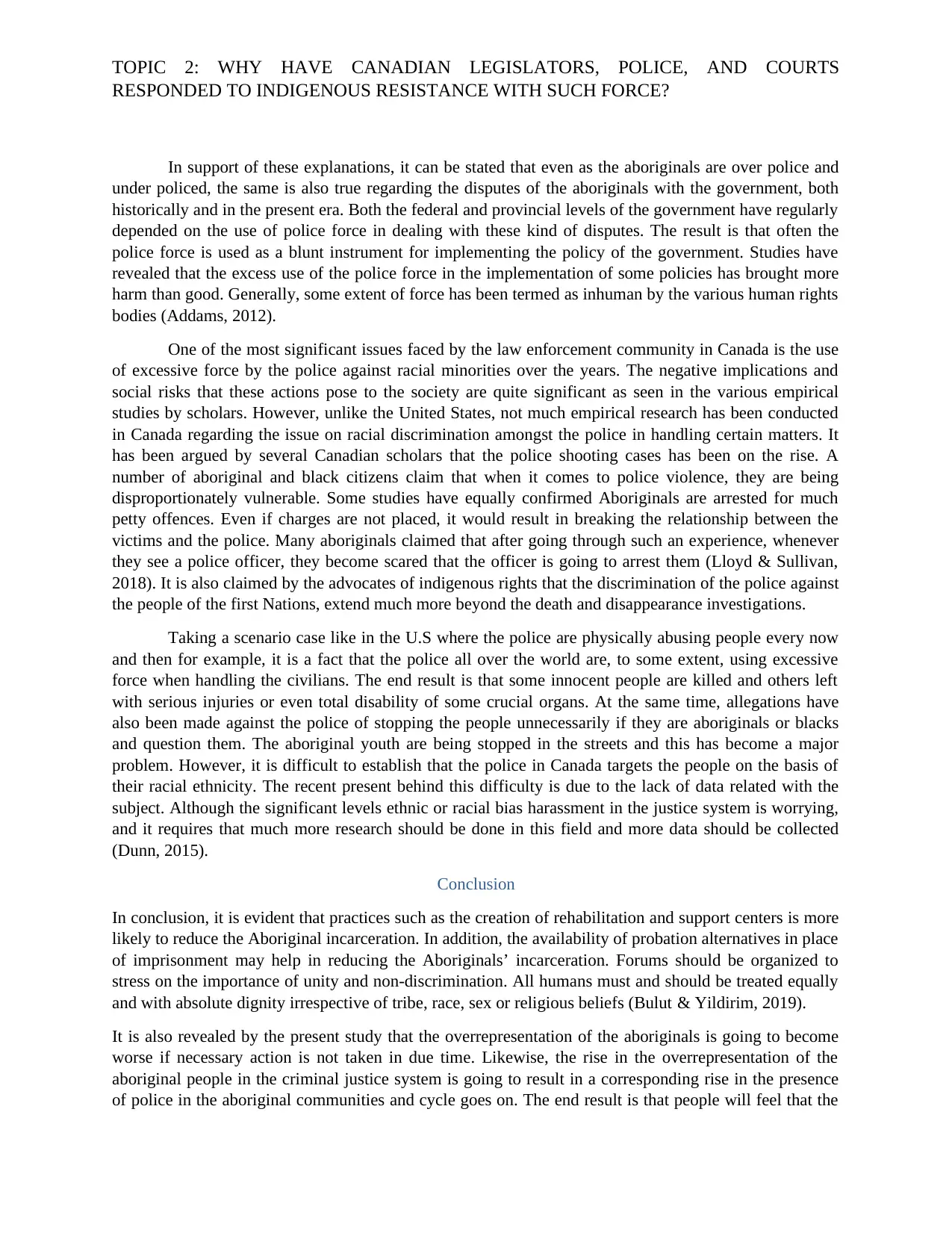
TOPIC 2: WHY HAVE CANADIAN LEGISLATORS, POLICE, AND COURTS
RESPONDED TO INDIGENOUS RESISTANCE WITH SUCH FORCE?
In support of these explanations, it can be stated that even as the aboriginals are over police and
under policed, the same is also true regarding the disputes of the aboriginals with the government, both
historically and in the present era. Both the federal and provincial levels of the government have regularly
depended on the use of police force in dealing with these kind of disputes. The result is that often the
police force is used as a blunt instrument for implementing the policy of the government. Studies have
revealed that the excess use of the police force in the implementation of some policies has brought more
harm than good. Generally, some extent of force has been termed as inhuman by the various human rights
bodies (Addams, 2012).
One of the most significant issues faced by the law enforcement community in Canada is the use
of excessive force by the police against racial minorities over the years. The negative implications and
social risks that these actions pose to the society are quite significant as seen in the various empirical
studies by scholars. However, unlike the United States, not much empirical research has been conducted
in Canada regarding the issue on racial discrimination amongst the police in handling certain matters. It
has been argued by several Canadian scholars that the police shooting cases has been on the rise. A
number of aboriginal and black citizens claim that when it comes to police violence, they are being
disproportionately vulnerable. Some studies have equally confirmed Aboriginals are arrested for much
petty offences. Even if charges are not placed, it would result in breaking the relationship between the
victims and the police. Many aboriginals claimed that after going through such an experience, whenever
they see a police officer, they become scared that the officer is going to arrest them (Lloyd & Sullivan,
2018). It is also claimed by the advocates of indigenous rights that the discrimination of the police against
the people of the first Nations, extend much more beyond the death and disappearance investigations.
Taking a scenario case like in the U.S where the police are physically abusing people every now
and then for example, it is a fact that the police all over the world are, to some extent, using excessive
force when handling the civilians. The end result is that some innocent people are killed and others left
with serious injuries or even total disability of some crucial organs. At the same time, allegations have
also been made against the police of stopping the people unnecessarily if they are aboriginals or blacks
and question them. The aboriginal youth are being stopped in the streets and this has become a major
problem. However, it is difficult to establish that the police in Canada targets the people on the basis of
their racial ethnicity. The recent present behind this difficulty is due to the lack of data related with the
subject. Although the significant levels ethnic or racial bias harassment in the justice system is worrying,
and it requires that much more research should be done in this field and more data should be collected
(Dunn, 2015).
Conclusion
In conclusion, it is evident that practices such as the creation of rehabilitation and support centers is more
likely to reduce the Aboriginal incarceration. In addition, the availability of probation alternatives in place
of imprisonment may help in reducing the Aboriginals’ incarceration. Forums should be organized to
stress on the importance of unity and non-discrimination. All humans must and should be treated equally
and with absolute dignity irrespective of tribe, race, sex or religious beliefs (Bulut & Yildirim, 2019).
It is also revealed by the present study that the overrepresentation of the aboriginals is going to become
worse if necessary action is not taken in due time. Likewise, the rise in the overrepresentation of the
aboriginal people in the criminal justice system is going to result in a corresponding rise in the presence
of police in the aboriginal communities and cycle goes on. The end result is that people will feel that the
RESPONDED TO INDIGENOUS RESISTANCE WITH SUCH FORCE?
In support of these explanations, it can be stated that even as the aboriginals are over police and
under policed, the same is also true regarding the disputes of the aboriginals with the government, both
historically and in the present era. Both the federal and provincial levels of the government have regularly
depended on the use of police force in dealing with these kind of disputes. The result is that often the
police force is used as a blunt instrument for implementing the policy of the government. Studies have
revealed that the excess use of the police force in the implementation of some policies has brought more
harm than good. Generally, some extent of force has been termed as inhuman by the various human rights
bodies (Addams, 2012).
One of the most significant issues faced by the law enforcement community in Canada is the use
of excessive force by the police against racial minorities over the years. The negative implications and
social risks that these actions pose to the society are quite significant as seen in the various empirical
studies by scholars. However, unlike the United States, not much empirical research has been conducted
in Canada regarding the issue on racial discrimination amongst the police in handling certain matters. It
has been argued by several Canadian scholars that the police shooting cases has been on the rise. A
number of aboriginal and black citizens claim that when it comes to police violence, they are being
disproportionately vulnerable. Some studies have equally confirmed Aboriginals are arrested for much
petty offences. Even if charges are not placed, it would result in breaking the relationship between the
victims and the police. Many aboriginals claimed that after going through such an experience, whenever
they see a police officer, they become scared that the officer is going to arrest them (Lloyd & Sullivan,
2018). It is also claimed by the advocates of indigenous rights that the discrimination of the police against
the people of the first Nations, extend much more beyond the death and disappearance investigations.
Taking a scenario case like in the U.S where the police are physically abusing people every now
and then for example, it is a fact that the police all over the world are, to some extent, using excessive
force when handling the civilians. The end result is that some innocent people are killed and others left
with serious injuries or even total disability of some crucial organs. At the same time, allegations have
also been made against the police of stopping the people unnecessarily if they are aboriginals or blacks
and question them. The aboriginal youth are being stopped in the streets and this has become a major
problem. However, it is difficult to establish that the police in Canada targets the people on the basis of
their racial ethnicity. The recent present behind this difficulty is due to the lack of data related with the
subject. Although the significant levels ethnic or racial bias harassment in the justice system is worrying,
and it requires that much more research should be done in this field and more data should be collected
(Dunn, 2015).
Conclusion
In conclusion, it is evident that practices such as the creation of rehabilitation and support centers is more
likely to reduce the Aboriginal incarceration. In addition, the availability of probation alternatives in place
of imprisonment may help in reducing the Aboriginals’ incarceration. Forums should be organized to
stress on the importance of unity and non-discrimination. All humans must and should be treated equally
and with absolute dignity irrespective of tribe, race, sex or religious beliefs (Bulut & Yildirim, 2019).
It is also revealed by the present study that the overrepresentation of the aboriginals is going to become
worse if necessary action is not taken in due time. Likewise, the rise in the overrepresentation of the
aboriginal people in the criminal justice system is going to result in a corresponding rise in the presence
of police in the aboriginal communities and cycle goes on. The end result is that people will feel that the
Secure Best Marks with AI Grader
Need help grading? Try our AI Grader for instant feedback on your assignments.
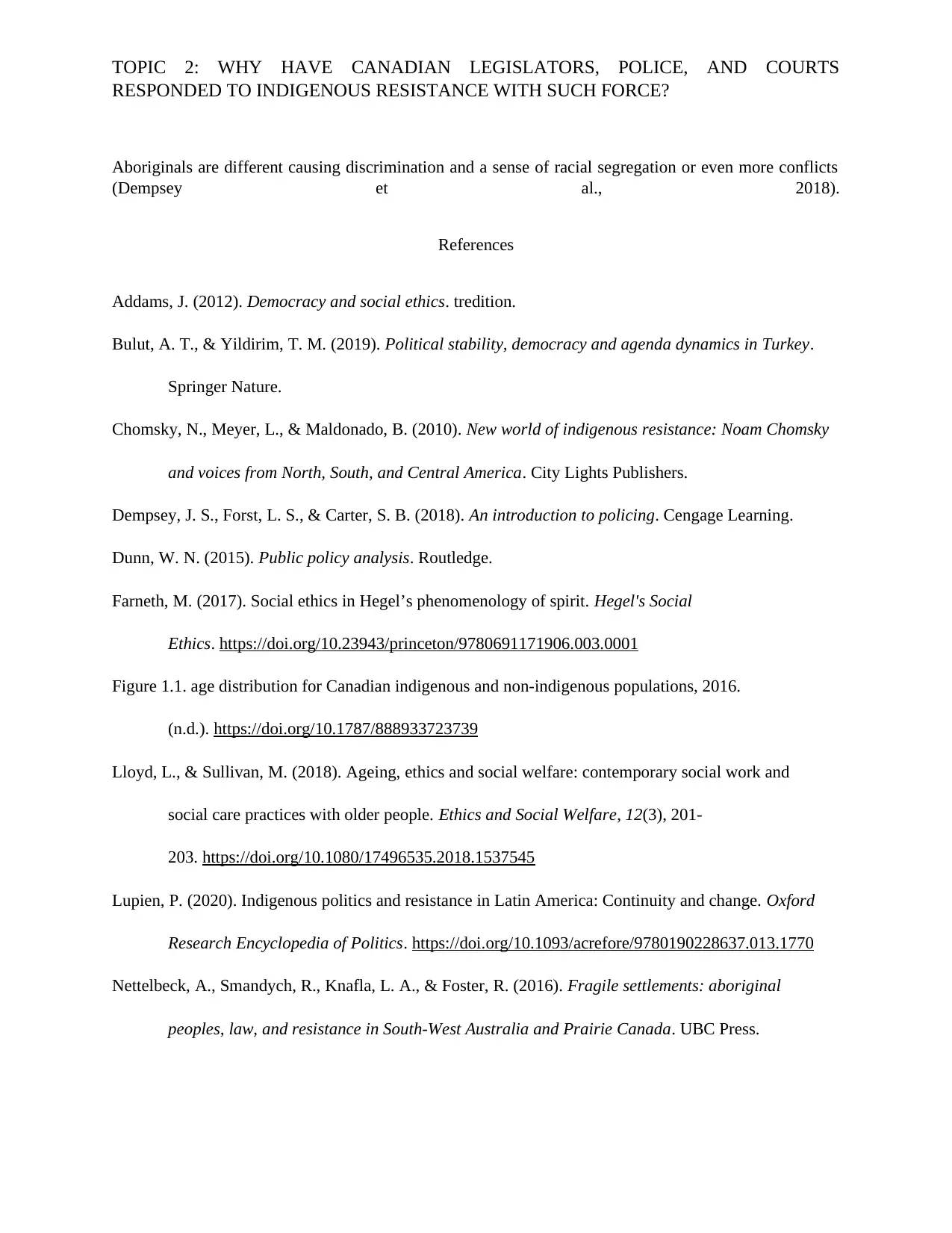
TOPIC 2: WHY HAVE CANADIAN LEGISLATORS, POLICE, AND COURTS
RESPONDED TO INDIGENOUS RESISTANCE WITH SUCH FORCE?
Aboriginals are different causing discrimination and a sense of racial segregation or even more conflicts
(Dempsey et al., 2018).
References
Addams, J. (2012). Democracy and social ethics. tredition.
Bulut, A. T., & Yildirim, T. M. (2019). Political stability, democracy and agenda dynamics in Turkey.
Springer Nature.
Chomsky, N., Meyer, L., & Maldonado, B. (2010). New world of indigenous resistance: Noam Chomsky
and voices from North, South, and Central America. City Lights Publishers.
Dempsey, J. S., Forst, L. S., & Carter, S. B. (2018). An introduction to policing. Cengage Learning.
Dunn, W. N. (2015). Public policy analysis. Routledge.
Farneth, M. (2017). Social ethics in Hegel’s phenomenology of spirit. Hegel's Social
Ethics. https://doi.org/10.23943/princeton/9780691171906.003.0001
Figure 1.1. age distribution for Canadian indigenous and non-indigenous populations, 2016.
(n.d.). https://doi.org/10.1787/888933723739
Lloyd, L., & Sullivan, M. (2018). Ageing, ethics and social welfare: contemporary social work and
social care practices with older people. Ethics and Social Welfare, 12(3), 201-
203. https://doi.org/10.1080/17496535.2018.1537545
Lupien, P. (2020). Indigenous politics and resistance in Latin America: Continuity and change. Oxford
Research Encyclopedia of Politics. https://doi.org/10.1093/acrefore/9780190228637.013.1770
Nettelbeck, A., Smandych, R., Knafla, L. A., & Foster, R. (2016). Fragile settlements: aboriginal
peoples, law, and resistance in South-West Australia and Prairie Canada. UBC Press.
RESPONDED TO INDIGENOUS RESISTANCE WITH SUCH FORCE?
Aboriginals are different causing discrimination and a sense of racial segregation or even more conflicts
(Dempsey et al., 2018).
References
Addams, J. (2012). Democracy and social ethics. tredition.
Bulut, A. T., & Yildirim, T. M. (2019). Political stability, democracy and agenda dynamics in Turkey.
Springer Nature.
Chomsky, N., Meyer, L., & Maldonado, B. (2010). New world of indigenous resistance: Noam Chomsky
and voices from North, South, and Central America. City Lights Publishers.
Dempsey, J. S., Forst, L. S., & Carter, S. B. (2018). An introduction to policing. Cengage Learning.
Dunn, W. N. (2015). Public policy analysis. Routledge.
Farneth, M. (2017). Social ethics in Hegel’s phenomenology of spirit. Hegel's Social
Ethics. https://doi.org/10.23943/princeton/9780691171906.003.0001
Figure 1.1. age distribution for Canadian indigenous and non-indigenous populations, 2016.
(n.d.). https://doi.org/10.1787/888933723739
Lloyd, L., & Sullivan, M. (2018). Ageing, ethics and social welfare: contemporary social work and
social care practices with older people. Ethics and Social Welfare, 12(3), 201-
203. https://doi.org/10.1080/17496535.2018.1537545
Lupien, P. (2020). Indigenous politics and resistance in Latin America: Continuity and change. Oxford
Research Encyclopedia of Politics. https://doi.org/10.1093/acrefore/9780190228637.013.1770
Nettelbeck, A., Smandych, R., Knafla, L. A., & Foster, R. (2016). Fragile settlements: aboriginal
peoples, law, and resistance in South-West Australia and Prairie Canada. UBC Press.
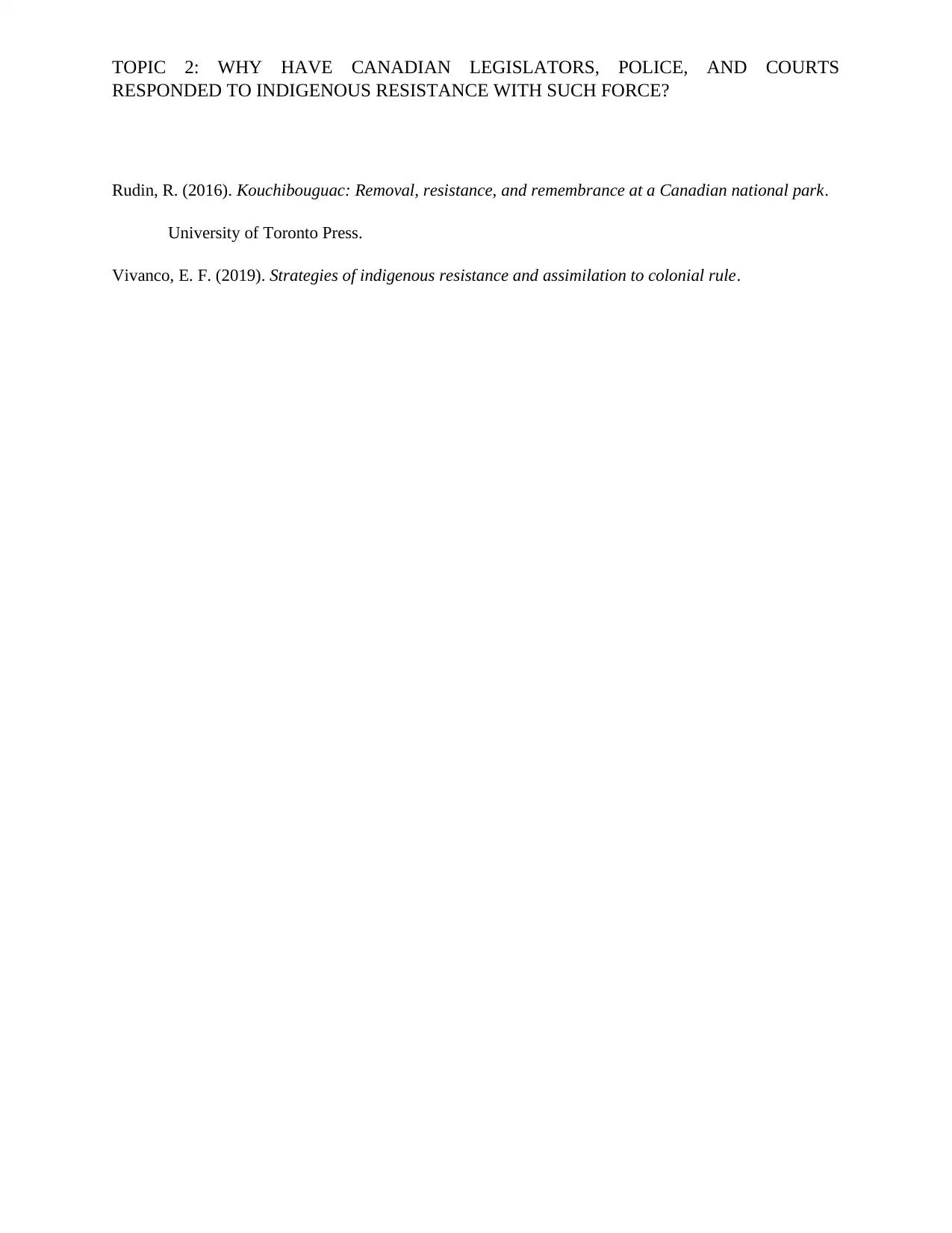
TOPIC 2: WHY HAVE CANADIAN LEGISLATORS, POLICE, AND COURTS
RESPONDED TO INDIGENOUS RESISTANCE WITH SUCH FORCE?
Rudin, R. (2016). Kouchibouguac: Removal, resistance, and remembrance at a Canadian national park.
University of Toronto Press.
Vivanco, E. F. (2019). Strategies of indigenous resistance and assimilation to colonial rule.
RESPONDED TO INDIGENOUS RESISTANCE WITH SUCH FORCE?
Rudin, R. (2016). Kouchibouguac: Removal, resistance, and remembrance at a Canadian national park.
University of Toronto Press.
Vivanco, E. F. (2019). Strategies of indigenous resistance and assimilation to colonial rule.
1 out of 6
Related Documents
Your All-in-One AI-Powered Toolkit for Academic Success.
+13062052269
info@desklib.com
Available 24*7 on WhatsApp / Email
![[object Object]](/_next/static/media/star-bottom.7253800d.svg)
Unlock your academic potential
© 2024 | Zucol Services PVT LTD | All rights reserved.





